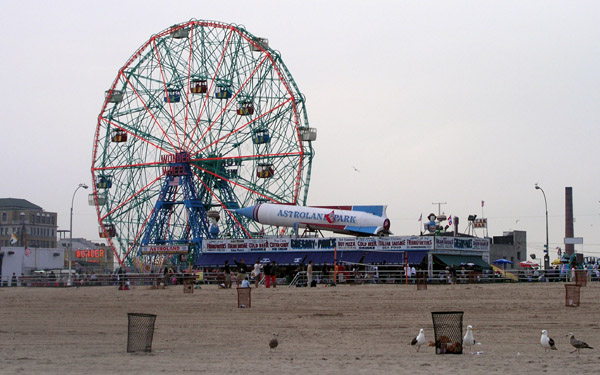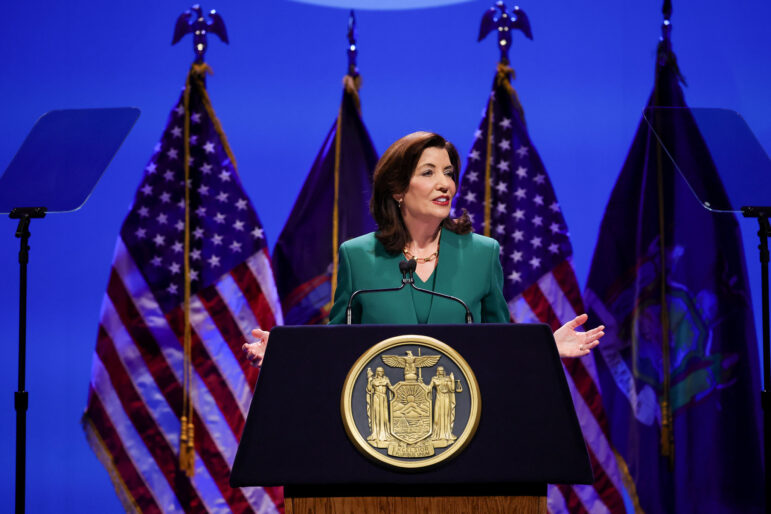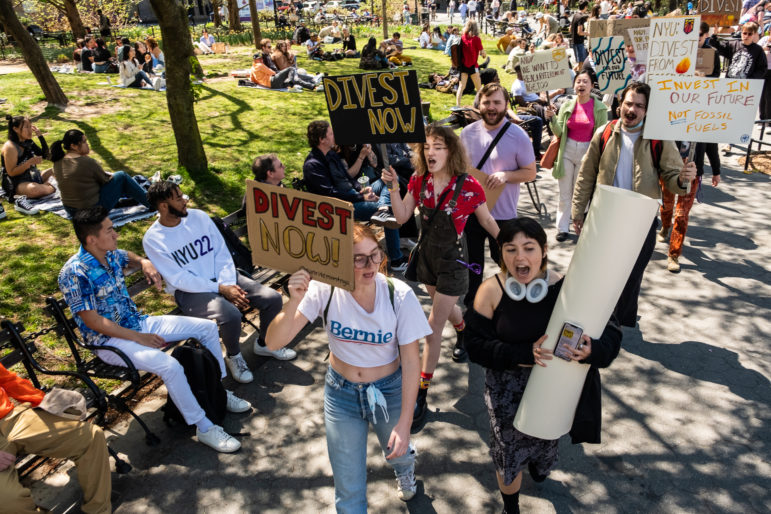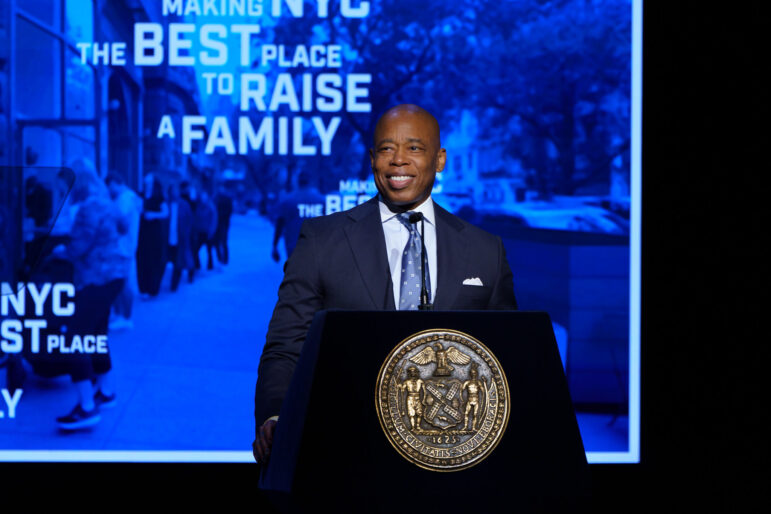
Photo by: courtesy of alex756/wikimediacommons
The Coney Island beachfront could soon look very different from its Astroland heyday.
For Zamperla, the acclaimed developers of Coney Island’s new Luna Park, the honeymoon didn’t last long. Just five months after opening Coney Island’s first new amusement park in half a century, the Italian-based amusement-ride company came under fire for announcing early this month that it would not renew leases for eight of the 11 businesses occupying the boardwalk properties that it leases from the city. Gone would be Ruby’s Bar & Grill, a Coney institution dating to 1934, as well as several other food vendors and the popular Shoot the Freak game. Only a Nathan’s satellite store and two souvenir shops would survive.
Zamperla’s stated reason for booting out so many longtime Coney businesses: Ruby’s and its neighbors, said company officials, didn’t fit with their vision of year-round boardwalk attractions that could draw visitors outside of the traditional summer season. “They didn’t have the vision that we have for the Boardwalk,” CAI president Valerio Ferrari told the Coney Island blog Amusing the Zillion. “It’s a business decision.”
The announcement surprised several business owners who say they had already sunk tens of thousands of dollars into store improvements in anticipation of new leases. But to veterans of the seven-year-long battle over the future of Coney Island, the evictions were a continuation of Bloomberg administration desires. Creating a “year-round” Coney has been a common refrain of city officials since 2003, when the city Economic Development Corporation initiated its efforts to rezone the area to include more mixed uses than the district’s traditional summer-only roller coasters and skeeball parlors.
In theory, all sides agree, a year-round Coney Island could have numerous benefits. When city officials presented their initial plans for the rezoning, they talked of the year-round jobs that would be created for Coney Island’s largely impoverished West End, and showed off dazzling computer renderings showing new roller coasters swooping amidst glass skyscrapers.
And while advocates of traditional amusements worried about the effect all this would have on ride operators – in particular, how they would afford year-round market rents on seasonal revenues – some noted that during Coney’s heyday, the winter season was much busier than today. “Historically, the boardwalk was much more year-round than it has been in recent years,” notes Juan Rivero, a former city housing policy analyst who is now the public face of the preservationist group Save Coney Island. “You see old pictures and you see people being wheeled with these blankets on.”
Yet after seven years of legal wrangling, hundreds of millions of dollars in city expense, and the eviction of many of Coney Island’s historic amusement operators, the promise of a year-round Coney Island remains clouded with uncertainty. In 2009 — after years of public fights with both amusement operators and Joe Sitt, a Brooklyn developer who’d snapped up much of the beachfront and announced plans to erect condo towers right on the beach, against the city’s wishes — the city council finally passed a rezoning to allow more entertainment uses in the amusement area, and residential development elsewhere. Later that year, the city finally bought out much of Sitt’s property, and gave Zamperla a ten-year lease to open a new amusement park and rent out the retail space along the boardwalk.
But the mixed-use towers that the city wanted built on the island to attract new residents and businesses won’t be built for years, if ever, with massive infrastructure improvements needed before any concrete can be poured. It’s a turn of events that’s left Zamperla, as the city’s best hope for a year-round Coney Island – a role that, some Coney denizens suggest, might be more than it can handle.
A Winter Wonderland?
Visit Coney Island in wintertime, and you’ll soon discover why it’s traditionally been a summer beach resort. Bitter winds whip off the Atlantic much of the time, sand-blasting everything in sight, and producing a ghostly howl as it whistles through the Astrotower, left derelict since its namesake Astroland amusement park was evicted by Sitt in 2008.
Yet the allure of finding something – anything – to provide a tourist draw in place of the amusement parks and bath houses that crowded the beachfront until the 1960s has tempted generations of urban planners. In the late 1970s, historian Charles Denson recounts in his book “Coney Island: Lost and Found,” the Coney Island Chamber of Commerce erected a huge billboard near the Belt Parkway reading, “Welcome To Coney Island, the Perfect Resort for Casino Gambling.” After then-Mayor Ed Koch endorsed the idea, boardwalk property values briefly soared from $3 to $100 per square foot, before collapsing once it became clear that the state legislature would never allow Atlantic City-style gambling in Brooklyn.
The next vision for Coney Island – articulated by the Coney Island Development Corporation, the entity that the city’s Economic Development Corporation created in 2003 to lead the rezoning efforts — dispensed with the casino dream in favor of an even more ambitious scenario. Their plan called for the rezoning of the amusement district, which once stretched more than a mile along the beachfront but in recent years has shrunk to only a few blocks, to allow for restaurants and “entertainment retail” along the lines of Chuck E. Cheese. At the same time, the proposed rezoning would harness the seemingly unquenchable thirst for residential real estate by converting much of the vacant land west of Stillwell Avenue — once the home of Steeplechase Park and surrounding attractions, now mostly parking for the Cyclones baseball stadium — for the construction of 30-story apartment towers, which would house restaurants and other amenities on their ground floors while providing thousands of ready-made customers for the enhanced amusement zone. In 2005, Mayor Bloomberg said that rezoning would generate the critical mass necessary to “capitalize on key assets such as the beautiful waterfront and KeySpan Park while attracting diverse new businesses that will transform Coney Island into a year-round visitor destination.”
The Best Laid Plans
The promise of rezoning, however, also transformed Coney Island into an attractive target for real estate speculators. By late 2005, Sitt, a Brooklyn-born developer who’d made his fortune by launching the Ashley Stewart line of plus-size clothing stores, had bought up much of the amusement area, including Coney Island’s largest amusement park, Astroland.
The following spring, Sitt started bulldozing rides, with the unmistakable message to the city that if it didn’t approve his condo plans, Coney would be nothing but vacant lots.
Sitt’s threats sparked years of public protests. (At one of Coney’s annual Mermaid Parades, demonstrators parodied the danger posed by Sitt’s Thor Equities development company by dressing up as Norse gods and carrying sliced-off mermaid tails.) Ultimately, the city held firm to its original plans, approving a rezoning bill only slightly changed from its original one in July 2009, and subsequently buying 6.9 acres of Sitt’s property for $95 million (about double what he’d paid for it) to create a new amusement park.
By then, however, the real estate market had collapsed, putting off much of the city’s hoped-for 2,500 units of residential development far into the future. Further complicating matters is the fact that the district’s infrastructure is still built for occasional skeeball patrons, not full-time residents. For decades, Coney Island has suffered from flooding every time it rains, the result of antiquated sewers that empty storm water straight into the ocean and back up in anything more than a light shower.
“When they first started talking about the redevelopment of Coney Island, we all thought the shovels were going into the ground next week,” says Ida Sanoff, a former member of Community Board 13 who has become a leading environmental champion for Coney Island and neighboring Brighton Beach. “But they have a lot to do underground.” Among other difficulties, she says, is that the city’s maps for the neighborhood are so out of date that when digging to repair a sewer, “you might find a pipe, or you might not find a pipe.”
The city now says it’s about to launch a major revamping of Coney Island’s drainage system that will include raising the grade of the land at the boardwalk by nine feet and building new sewers to drain storm runoff into Coney Island Creek to the north. The first phase, costing $130 million, is projected for completion by 2014; subsequent phases won’t be completed for at least another decade.
But the effort to construct the mixed-use towers remains stalled. After purchasing a $90 million lot, Taconic Properties, the developer that was to have built them now says on its web page for the Coney project that it is “in the process of evaluating the economics of a planned development for some or all of our holdings.” (Taconic officials did not respond to repeated requests for comment for this story.) Though city officials say Taconic has discussed erecting a single building on the old Washington Baths site at West 21st Street and the boardwalk, there’s no sign of activity anytime soon.
Enter Zamperla
With the housing towers stalled, the city has turned to Zamperla as the harbinger of a new, year-round Coney. Next year, the company will open its Scream Zone, a new amusement area that will feature two new rollercoasters and a “human slingshot,” on land that was home to batting cages and go-cart rides before Sitt put his bulldozers to work. Zamperla is also considered likely to take over operations of the Cyclone roller coaster now that former Astroland owner Carol Hill Albert has opted out of her long-term lease, citing rising insurance costs.
“The goal is ultimately a Coney Island capable of attracting visitors 365 days a year,” CAI president Ferrari tells City Limits via email. “It will be challenging, to be sure – but we believe it is possible. And a resurgent Boardwalk is essential to accomplishing this goal.”
It’s that goal, says Ferrari, that led Zamperla to give the boardwalk businesses the boot, in order to bring in what he calls “a new and exciting mix of world-class dining, nightlife and entertainment options.” Ruby’s staffers claimed that Zamperla told them they’d be replaced by a sports bar; other rumors had the company in negotiations with chains Shake Shack and Atomic Wings to open boardwalk outlets. Whether or not the city was involved in the lease decision – a common accusation along the boardwalk, though neither EDC nor Zamperla will confirm or deny it – the result certainly meshes with EDC’s stated redevelopment goals.
“Zamperla is putting far more resources into this than we ever anticipated,” says EDC vice-president Madelyn Wils, noting that Luna Park plans to open a restaurant on its Surf Avenue frontage next spring. “Even though it’s not a permanent amusement park,” she says – Zamperla’s lease expires after 2019, at which point the city will issue a new RFP for a permanent amusement operator – “it should spur a lot of economic growth.”
Tivoli or Tattoos
Which new businesses will open on the boardwalk next spring remains unclear. No new tenants have yet been announced, and Ruby’s has promised a court battle over its lease.
Still, to Dick Zigun, the self-proclaimed “mayor of Coney Island” who has operated his Sideshows by the Seashore for nearly three decades, Zamperla’s plan to become a year-round anchor looks promising. “Our [Halloween] program, Creepshow at the Freakshow, which lost money and never found an audience for 12 years, was sold out for every performance” this year after Luna Park stayed open for an added month past the traditional September beach closing date, Zigun says. “So Hallelujah, the new Coney Island!” He notes that a handful of new year-round businesses are in the process of opening on Surf Avenue – though they’re likely not what the Bloomberg administration had in mind. “There is a biker bar across the street from us, a topless club. There is a tattoo parlor under construction and a karaoke bar under construction directly across the street. So instead of our immediate neighborhood rolling down steel shutters at 5 pm, there’s the beginning of a nightclub district that’s open evenings.”
Still, say many Coney denizens, it’s an open question as to whether thrill rides and a handful of sports bars and restaurants will be enough to lure tourists to the boardwalk in, say, January. “I love Coney Island in the winter, but it’s an acquired taste,” says Denson. “Are people going to take the train out there to sit in an expensive restaurant and look out into the darkness? It works in Brighton, but there’s a lot more going on there in the winter.”
“You have to have a critical mass of things that can provide shelter part of the year,” agrees Rivero. “Roller coasters don’t really work in the dead of winter.” Tivoli Gardens, the Copenhagen seaside park with a famed winter light show that the city has held up as a model for Coney Island, “works in the offseason because it’s very pretty,” he says. “I don’t want to malign what Zamperla has put together, but pretty it is not.”








